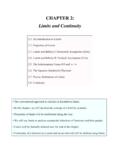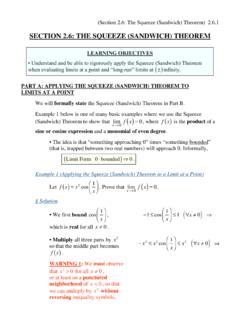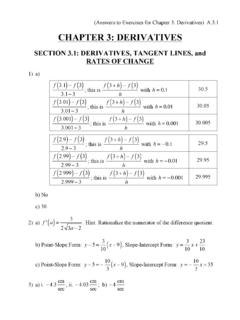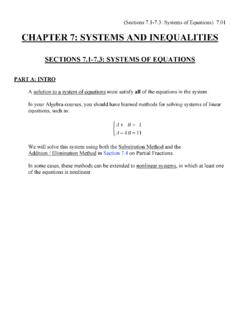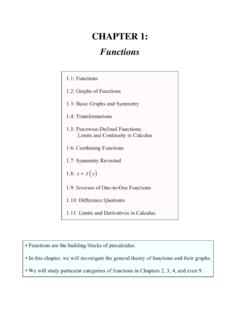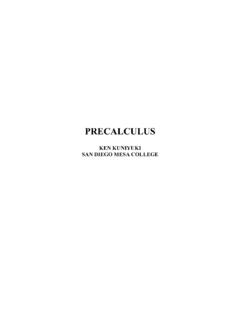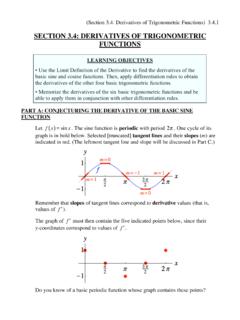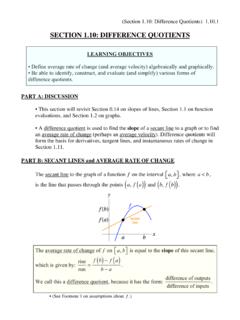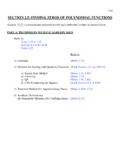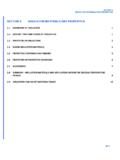Transcription of SECTION 2.2: PROPERTIES OF LIMITS and …
1 ( SECTION : PROPERTIES of LIMITS and algebraic functions ) : PROPERTIES OF LIMITS and algebraic functions LEARNING OBJECTIVES Know PROPERTIES of LIMITS , and use them to evaluate LIMITS of functions , particularly algebraic functions . Understand how the PROPERTIES of LIMITS justify the limit theorems in SECTION Be able to use informal Limit Form notation to analyze LIMITS . Learn to exercise caution when handling Limit Form 0even(). PART A: PROPERTIES OF LIMITS / THE ALGEBRA OF LIMITS ; LIMIT FORMS Assume that: limx afx()=L1, and limx agx()=L2, where a,L1,L2 . 1) The limit of a sum equals the sum of the LIMITS . limx afx()+gx() =limx afx()+limx agx()=L1+L2 We may refer to this as the Sum Rule of LIMITS . For example, as x a, if fx() 2 and gx() 3, then fx()+gx() 5.
2 We can represent this informally using a Limit Form: Limit Form 2+3() 5. WARNING 1: Limit Forms. There is no standard notation for Limit Forms, and they represent footnotes to the rigorous evaluation of LIMITS . Different instructors may have different rules on when Limit Forms need to be written. 2) The limit of a difference equals the difference of the LIMITS . limx afx() gx() =limx afx() limx agx()=L1 L2 For example, Limit Form 5 3() 2. ( SECTION : PROPERTIES of LIMITS and algebraic functions ) 3) The limit of a product equals the product of the LIMITS . limx afx()gx() , or limx afx()gx()=limx afx() limx agx() =L1L2 For example, Limit Form 2 3() 6. 4) The limit of a quotient equals the quotient of the LIMITS , if the limit of the divisor (or denominator) is not zero. limx afx()gx() , or limx afx()gx()=limx afx()limx agx()=L1L2, if L2 0 For example, Limit Form 62 3.
3 5) The limit of a (positive integer) power equals the power of the limit. If n is a positive integer n +(), then: limx afx() n=limx afx() n=L1()n This is a direct consequence of Property 3. For instance, limx ax2=limx axx=limx ax()limx ax()=limx ax()2. For example, Limit Form 2constant 3()() 8. The seemingly simpler statement Limit Form 23() 8 is also true, but it actually says something more powerful. It says that something approaching 2 raised to an exponent approaching 3 will approach 8. However, this idea falls apart when the base fx() approaches a negative number. It is true that Limit Form 2()constant 3()() 8, for example, but it is not true that Limit Form 2()3() 8. Think about why 2() , or 2()7/2 , is not a real number; we will address this issue in Part B. ( SECTION : PROPERTIES of LIMITS and algebraic functions ) 6) The limit of a constant multiple equals the constant multiple of the limit.
4 ( Constant Factors Pop Out. ) If c , then: limx ac fx() , or limx acf x()=c limx afx()=cL1 For example, twice something that approaches 3 will approach 6. In multivariable calculus, if y is independent of x, then we can pop out y. Note: PROPERTIES 5, 6, and 7 (upcoming) are generalized in SECTION , Footnote 6. Limit Operators are Linear PROPERTIES 1), 2), and 6) imply that limit operators are linear operators. This means that we can take LIMITS term-by-term, and then constant factors pop out, assuming the LIMITS exist. (See Footnote 1.) This is a key property that is shared by differentiation and integration operators in later chapters. PROPERTIES 1-6, building on the elementary rules limx ac=c and limx ax=a a,c (), justify the Basic Limit Theorem for Rational functions in SECTION A demonstration follows.
5 ( SECTION : PROPERTIES of LIMITS and algebraic functions ) Example 1 (Demonstrating How the PROPERTIES of LIMITS Justify the Basic Limit Theorem for Rational functions ) Evaluate limx 43x2 1x+5 using the PROPERTIES of LIMITS in this SECTION . Solution limx 43x2 1x+5=limx 43x2 1()limx 4x+5()by Property 4 on quotients()=limx 43x2 limx 41limx 4x+limx 45by PROPERTIES 1, 2 on sums, differences()=limx 43x2 14+5by elementary rules()=3 limx 4x2() 14+5by Property 6 on constant multiples()=3 limx 4x()2 14+5by Property 5 on powers, orby Property 3 on products: x2=xx =34()2 14+5by elementary rules; see Note 1 below()=479 Note 1: Observe that the limit can be evaluated by simply substituting x=4 into 3x2 1x+5, as the Basic Limit Theorem for Rational functions suggests. Note 2: Observe that all indicated LIMITS exist and there are no zero denominator issues, so we could apply PROPERTIES 1-6.
6 Our use of the = sign is appropriate here, though we often use it informally even when the limit turns out not to exist. ( SECTION : PROPERTIES of LIMITS and algebraic functions ) PROPERTIES of One-Sided LIMITS PROPERTIES 1-6 extend naturally to one-sided LIMITS . For example, limx a fx()+gx() =limx a fx()+limx a gx(), and limx a+fx()+gx() =limx a+fx()+limx a+gx(), provided the indicated LIMITS exist. PART B: PROPERTIES OF LIMITS OF ROOTS We now motivate Property 7, a much more complicated property on roots. Example 2 (Evaluating the Limit of a Square Root) Evaluate limx 1x, limx 1x, limx 0+x, limx 0 x, and limx 0x. Solution The graph of y=x is below. We emphasize the interesting cases where a=0. limx 1x=1=1, evidently. limx 1x does not exist (DNE). Actually, this is not because 1 is imaginary.
7 It is because there is no punctured neighborhood of x= 1 on which x is real. There is no way to approach x= 1 through the domain of f , where f is the (principal) square root function. ( SECTION : PROPERTIES of LIMITS and algebraic functions ) Review SECTION , Example 6. Domf()=0, ) here, as well. limx 0+x=0=0. limx 0 x does not exist (DNE). Therefore, limx 0x does not exist (DNE). Example 3 (Evaluating the Limit of a Cube Root) Evaluate limx 1x3 and limx 0x3. Solution The graph of y=x3 is below. The domain of the cube root function is . The (principal) cube roots of negative real numbers are (negative) real numbers; this is a key difference from square roots. It turns out that substituting x=a works here for both LIMITS . limx 1x3= 13= 1. limx 0x3=03=0. Property 7 now extends our observations from Examples 2 and 3 to more general radicands, not just x, and also to general types of roots.
8 WARNING 2: In theory, even roots tend to require more thought than odd roots. ( SECTION : PROPERTIES of LIMITS and algebraic functions ) As before, assume limx afx()=L1. 7) The limit of a root equals the root of the limit .. sometimes. If n is a positive integer n +(), and either (n is odd), or (n is even, and L1>0), then: limx afx()n=limx afx()n=L1n For example, Limit Form 4() 2, and Limit Form 83() 2. (The index of a radical, such as the 3 in 83, is assumed to be a constant.) WARNING 3: The Limit Form 0even, corresponding to L1=0, could either yield a limit value of 0 or a limit that does not exist (DNE). Informally, Limit Form 0even() 0 or DNE, but further analysis is required to determine which is the case. Limit Forms such as 1 and 54 imply that the LIMITS do not exist (DNE).
9 Property 7* below elaborates on LIMITS of even roots. 7*) PROPERTIES of LIMITS of Even Roots Let n be a positive even integer. If L1>0, then limx afx()n=L1n by Property 7. If L1<0, then limx afx()n does not exist (DNE). The one-sided LIMITS limx a+fx()n and limx a fx()n also do not exist (DNE). If L1=0, then limx afx()n= 0 or DNE. In particular, limx afx()n=0 fx() 0 on some punctured neighborhood of a; change this to a right-neighborhood for a right-hand limit and a left-neighborhood for a left-hand limit. Otherwise, the limit does not exist (DNE). ( SECTION : PROPERTIES of LIMITS and algebraic functions ) PART C: LIMITS OF algebraic functions Our understanding of Property 7 will now allow us to extend our Basic Limit Theorem for Rational functions to more general algebraic functions .
10 Remember that: all constant functions are also polynomial functions , all polynomial functions are also rational functions , and all rational functions are also algebraic functions . Basic Limit Theorem for algebraic functions If f is an algebraic function, a Domf(), and no radicand of any even root approaches 0 in the limit (informally, the Limit Form 0even does not appear), then limx afx()=fa(). To evaluate the limit, substitute ( plug in ) x=a, and evaluate fa(). If the Limit Form 0even does appear, this substitution method might still work, but further analysis is required. How is the radicand approaching 0? Example 4 (Evaluating the Limit of an algebraic Function) Let fx()=x 433x 9()2+x+3. Evaluate limx 2fx(). Solution f is an algebraic function. Observe that: fx() is real x+3 0 and 3x 9()2 0.
